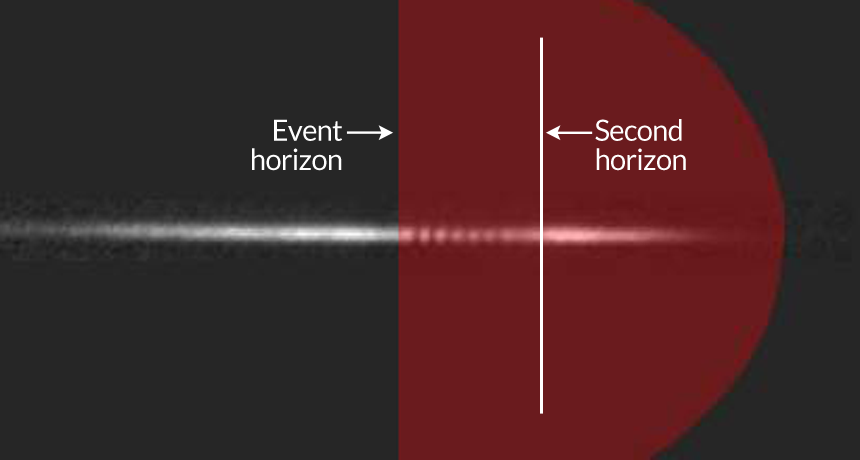Hawking radiation spotted within sonic black hole
Lab creation emits energy as famed physicist predicted, but experiment may not be definitive

RIPPLES OF RADIATION The pattern in this laser image between the event horizon of a sonic black hole and a second, inner horizon indicates the presence of Hawking radiation.
J. Steinhauer
A whisper from a lab-manufactured black hole may confirm the existence of radiation predicted by University of Cambridge physicist Stephen Hawking four decades ago. If validated by further research, the finding would offer evidence that particles blinking in and out of existence can rob black holes of mass.
“It’s amazing, groundbreaking work,” says Daniele Faccio, a physicist at Heriot-Watt University in Edinburgh. The work “demonstrates something that everyone thought was impossible.”
For decades, scientists thought of black holes as everlasting objects from which nothing, not even light, could escape. But in the mid-1970s, Hawking proposed an amendment to that rule with huge implications. He noted that quantum mechanics allows pairs of particles to spontaneously pop into existence in the vacuum of space. Usually those particles quickly annihilate each other. But if they formed at the event horizon — the black hole’s point of no return — then one particle could get dragged in, while the other could escape as energy called Hawking radiation. The fleeing particle would take a small fraction of the black hole’s mass with it, meaning that in the very far future, every black hole in the universe would fade away.
After initially expressing skepticism, physicists have largely embraced the idea of Hawking radiation, and today it lies at the heart of the quest to unify general relativity, the theory that explains the very large stuff in the universe, and quantum mechanics, which dictates the very small (SN: 5/31/14, p. 16). Yet confirming Hawking’s prediction is a tremendous challenge: The radiation emitted by black holes light-years away is almost certainly too feeble for detection by telescope.
Instead of looking for Hawking radiation in nature’s black holes, physicist Jeff Steinhauer at Technion-Israel Institute of Technology in Haifa conducted the search on a homemade black hole that traps sound rather than light. He used lasers to cool a vat of rubidium atoms to temperatures about a billionth of a degree above absolute zero. Then he set those supercooled atoms, known as a Bose-Einstein condensate, in motion, creating a raging river of rubidium. The event horizon of Steinhauer’s hole of silence emerged at the point where the rubidium’s flow rate broke the sound barrier: Any sound waves emitted beyond that spot could not escape upstream (SN: 12/18/10, p. 28).
The success of Steinhauer’s experiment hinged on observing pairs of sound waves that emerge from the vacuum at the event horizon. They would form via quantum fluctuations analogous to those predicted by Hawking to produce radiation around a real black hole. To make this acoustic Hawking radiation easier to detect, Steinhauer tried out a previously proposed strategy to make the radiation proliferate. He slowed down the rubidium atoms beyond the event horizon to create a second horizon, one that kept sound waves out rather than dragging them in. Together, the two horizons served as an amplifier: A sound wave that hit the second horizon would bounce back toward the first event horizon, where it would trigger more sound-wave pairs that parted ways at the black-hole boundary. “The Hawking radiation amplifies itself,” Steinhauer says.
About 120 milliseconds after Steinhauer set the rubidium atoms in motion, a rapidly intensifying cluster of sound waves rippled between the two horizons. At the same time, a corresponding batch of sound waves bolted from the homemade black hole, taking energy with it. In a study published October 12 in Nature Physics, Steinhauer reports the finding as the signature of Hawking radiation.
“I find it a very exciting and interesting experiment,” says William Unruh, a theoretical physicist at the University of British Columbia in Vancouver. “I would not say that the case is proven,” he says, adding that the observed sound waves could have come from an artifact in the Bose-Einstein condensate. “But it is probably the closest anyone has come.” In 1981, Unruh proposed creating black holes in the lab but wrote at the time that detecting Hawking radiation “is an extremely slim possibility.”
Faccio, who also builds black hole analogs and at one time had claimed to have detected Hawking radiation, says that Steinhauer has made a convincing case. “I think he is showing evidence that the fluctuations are coming from the quantum vacuum,” Faccio says. “The experiment works because Hawking’s predictions were correct.” But he adds that a definitive detection would require taking sensitive measurements of the generated sound waves, including determining whether they share a quantum connection called entanglement.
Even if Steinhauer’s findings are confirmed, it’s unclear how much a lab-produced sonic black hole can inform the processes governing a supermassive black hole in space. “Showing that the effect occurs in a Bose-Einstein condensate does not prove it would occur in black holes,” Unruh says. “However, it sure increases my confidence that it does. The mathematics and the results are too similar to just be a coincidence.”







